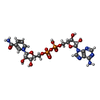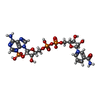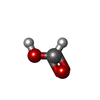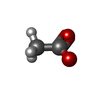+Search query
-Structure paper
| Title | Structural basis of light-induced redox regulation in the Calvin-Benson cycle in cyanobacteria. |
|---|---|
| Journal, issue, pages | Proc Natl Acad Sci U S A, Vol. 116, Issue 42, Page 20984-20990, Year 2019 |
| Publish date | Oct 15, 2019 |
 Authors Authors | Ciaran R McFarlane / Nita R Shah / Burak V Kabasakal / Blanca Echeverria / Charles A R Cotton / Doryen Bubeck / James W Murray /  |
| PubMed Abstract | Plants, algae, and cyanobacteria fix carbon dioxide to organic carbon with the Calvin-Benson (CB) cycle. Phosphoribulokinase (PRK) and glyceraldehyde 3-phosphate dehydrogenase (GAPDH) are essential ...Plants, algae, and cyanobacteria fix carbon dioxide to organic carbon with the Calvin-Benson (CB) cycle. Phosphoribulokinase (PRK) and glyceraldehyde 3-phosphate dehydrogenase (GAPDH) are essential CB-cycle enzymes that control substrate availability for the carboxylation enzyme Rubisco. PRK consumes ATP to produce the Rubisco substrate ribulose bisphosphate (RuBP). GAPDH catalyzes the reduction step of the CB cycle with NADPH to produce the sugar glyceraldehyde 3-phosphate (GAP), which is used for regeneration of RuBP and is the main exit point of the cycle. GAPDH and PRK are coregulated by the redox state of a conditionally disordered protein CP12, which forms a ternary complex with both enzymes. However, the structural basis of CB-cycle regulation by CP12 is unknown. Here, we show how CP12 modulates the activity of both GAPDH and PRK. Using thermophilic cyanobacterial homologs, we solve crystal structures of GAPDH with different cofactors and CP12 bound, and the ternary GAPDH-CP12-PRK complex by electron cryo-microscopy, we reveal that formation of the N-terminal disulfide preorders CP12 prior to binding the PRK active site, which is resolved in complex with CP12. We find that CP12 binding to GAPDH influences substrate accessibility of all GAPDH active sites in the binary and ternary inhibited complexes. Our structural and biochemical data explain how CP12 integrates responses from both redox state and nicotinamide dinucleotide availability to regulate carbon fixation. |
 External links External links |  Proc Natl Acad Sci U S A / Proc Natl Acad Sci U S A /  PubMed:31570616 / PubMed:31570616 /  PubMed Central PubMed Central |
| Methods | EM (single particle) / X-ray diffraction |
| Resolution | 1.32 - 3.9 Å |
| Structure data |  PDB-6gfo:  PDB-6gfp:  PDB-6gfq:  PDB-6gfr:  PDB-6gg7:  PDB-6ghl:  PDB-6ghr: |
| Chemicals |  ChemComp-NAD:  ChemComp-SO4:  ChemComp-HOH:  ChemComp-NAP:  ChemComp-MLI:  ChemComp-FMT:  ChemComp-MG:  ChemComp-ACT: |
| Source |
|
 Keywords Keywords | PHOTOSYNTHESIS / Calvin Cycle / Regulation / complex / redox regulation |
 Movie
Movie Controller
Controller Structure viewers
Structure viewers About Yorodumi Papers
About Yorodumi Papers






 thermosynechococcus elongatus bp-1 (bacteria)
thermosynechococcus elongatus bp-1 (bacteria)